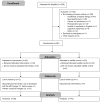Pilot randomized controlled trial of a patient-controlled cognitive-behavioral intervention for the pain, fatigue, and sleep disturbance symptom cluster in cancer
- PMID: 22771125
- PMCID: PMC3484234
- DOI: 10.1016/j.jpainsymman.2011.12.281
Pilot randomized controlled trial of a patient-controlled cognitive-behavioral intervention for the pain, fatigue, and sleep disturbance symptom cluster in cancer
Abstract
Context: Pain, fatigue, and sleep disturbance commonly co-occur in patients receiving treatment for advanced cancer.
Objectives: A pilot randomized controlled trial was conducted to assess initial efficacy of a patient-controlled cognitive-behavioral (CB) intervention for the pain, fatigue, and sleep disturbance symptom cluster.
Methods: Eighty-six patients with advanced lung, prostate, colorectal, or gynecologic cancers receiving treatment at a comprehensive cancer center were stratified by recruitment clinics (chemotherapy and radiation therapy) and randomized to intervention or control groups. Forty-three patients were assigned to receive training in and use of up to 12 relaxation, imagery, or distraction exercises delivered via an MP3 player for two weeks during cancer treatment. Forty-three patients were assigned to a waitlist control condition for the same two week period. Outcomes included symptom cluster severity and overall symptom interference with daily life measured at baseline (Time 1) and two weeks later (Time 2).
Results: Eight participants dropped out; 78 completed the study and were analyzed (36 intervention and 42 control subjects). Participants used the CB strategies an average of 13.65 times (SD=6.98). Controlling for baseline symptom cluster severity and other relevant covariates, it was found that the symptom cluster severity at Time 2 was lower in the intervention group (M(Adj)=2.99, SE=0.29) than in the waitlist group (M(Adj)=3.87, SE=0.36), F(1, 65)=3.57, P=0.032. Symptom interference with daily life did not differ between groups. No significant adverse events were noted with the CB intervention.
Conclusion: Findings suggest that the CB intervention may be an efficacious approach to treating the pain, fatigue, and sleep disturbance symptom cluster. Future research is planned to confirm efficacy and test mediators and moderators of intervention effects.
Trial registration: ClinicalTrials.gov NCT00946803.
Copyright © 2012 U.S. Cancer Pain Relief Committee. Published by Elsevier Inc. All rights reserved.
Conflict of interest statement
The authors have no financial or other conflicts of interest to disclose. The content is solely the responsibility of the authors and does not necessarily represent the official views of the National Institute of Nursing Research or the National Institutes of Health. ClinicalTrials.gov Identifier: NCT00946803
Figures
References
-
- Beck S, Dudley WN, Barsevick AM. Using a mediation model to test a symptom cluster: pain, sleep disturbance, and fatigue in cancer patients. Oncol Nurs Forum. 2005;32:E48–E55. - PubMed
-
- Esper P. Symptom clusters in individuals living with advanced cancer. Semin Oncol Nurs. 2010;26:168–174. - PubMed
-
- Lidstone V, Butters E, Seed PT, et al. Symptoms and concerns amongst cancer outpatients: identifying the need for specialist palliative care. Palliat Med. 2003;17:588–595. - PubMed
-
- Johnsen AT, Petersen MA, Pedersen L, Groenvold M. Symptoms and problems in a nationally representative sample of advanced cancer patients. Palliat Med. 2009;23:491–501. - PubMed
-
- Kirkova J, Walsh D, Davis M, Rybicki L. Symptom prevalence and symptom severity across different primary sites in 1000 advanced cancer patients. J Palliat Care. 2006;22:245.
Publication types
MeSH terms
Associated data
Grants and funding
LinkOut - more resources
Full Text Sources
Medical



